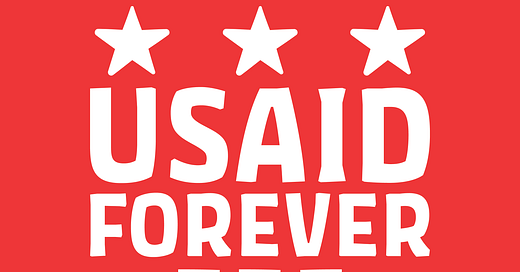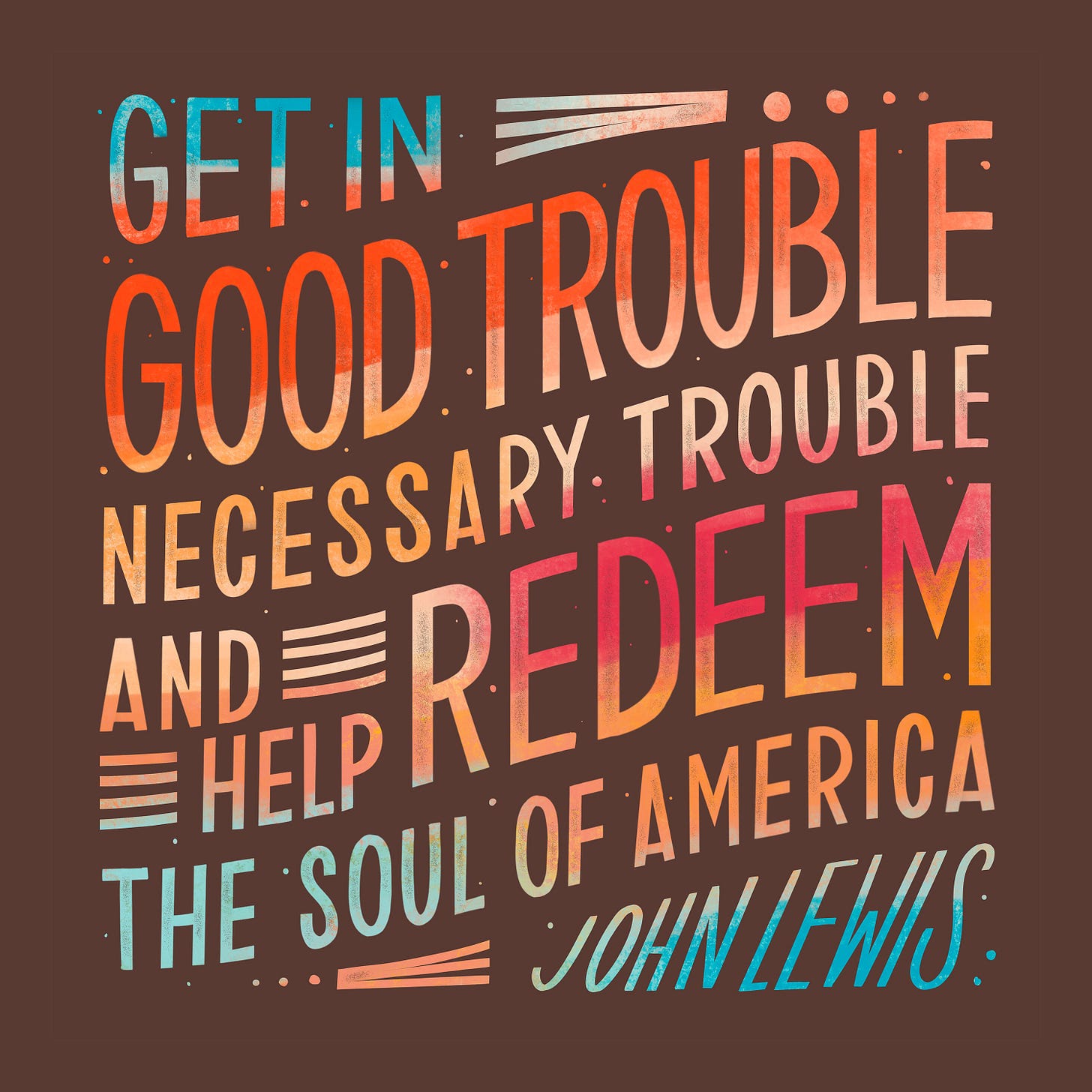From Grief to Grit: Reclaiming Purpose in the Aftermath of USAID
It's time to stir up some Good Trouble
We’re here, folks. The final week. Sure, some of us will still be on the books until September, and there’s always the far-flung hope that the courts and Congress will finally step in like some final-act superhero to save the day. But the truth can’t be ignored—no matter what happens in the coming months and years, USAID as we know it has ended. And as of July 1, nearly all of us will be officially cut loose.
Since January, many of us have been working under siege, suppressing our fury, watching the mission we devoted our lives to be dismantled piece by piece. Despite our own moral injuries, we've held the line out of duty. Out of fear. Out of love for the people we serve and the issues we care about. And now, in this liminal space between endings and whatever comes next, the question before us is both daunting and electric:
What do we do now?
The Trouble We’ve Inherited
What’s happening is bigger than a job loss. This is a systemic erasure of expertise and institutional memory. It’s a political gutting of a lifeline that connected U.S. leadership to global partnerships and lifesaving work.
We know what $45 million can do—not for tanks in a parade, but for HIV medications, school feeding programs, and disaster response. The misuse of power and money isn’t abstract to us. It’s visceral.
For the last six months, we’ve watched decisions implemented that hurt the people we came to serve. We’ve seen policies warped, gutted, or buried. We’ve had to smile through it, write the talking points, stay quiet for the sake of the mission—or at least, what remained of it. This is what we mean by moral injury.
But one of the best remedies for this sort of injury is action—reclaiming your agency, your power, your voice.
Now is the time to remember Congressman John Lewis’s call to arms: "Get in good trouble, necessary trouble."
But how do you cause good trouble when you’re burnt out, newly unemployed, and maybe still trying to figure out your COBRA paperwork?
Let’s talk about that.
What Is Good Trouble?
Good trouble isn’t noise. It’s not a tantrum. It's not chaos for chaos’s sake.
It's courageous dissent. It’s principled disruption with purpose. It's refusing to let wrongdoing go unchallenged, even if it’s inconvenient. Especially when it's inconvenient. And right now, we have a rare and precious opportunity to act without the constraints that once muzzled us.
So how do you do it?
Step 1. Pick Your Lane
There are so many ways to engage, but the secret to sustainable advocacy is narrowing your focus. Find an issue or two that matters most to you, and then concentrate your efforts to maximize impact.
Once you’ve chosen your area of focus, choose a few ways to use your voice. Each of us has unique talents, and advocacy work can be tailored to your particular skillset and emotional capacity.
Start small. Ask yourself:
What injustice keeps me up at night?
Where does my skill set make me (peacefully) dangerous to the status quo?
What can I contribute that is mine—not performative, not draining, but rooted in conviction?
Step 2. Pick Your Platform
It doesn’t have to be loud or dramatic. Good trouble can be a well-researched op-ed, a blistering spreadsheet, a batch of FOIA requests, or an anonymous tip to a journalist. It can be helping organize local elections or volunteering legal skills in asylum cases.
It can also be deeply local: helping protect a library, stopping a book ban, creating a safer public space for kids to play.
You can:
Write: Submit op-eds. Share your story. Connect the dots between funding cuts and human cost. Hold your representatives accountable.
Show up: Go to town halls. Ask pointed questions. Organize others to go with you.
Volunteer: From HIV work to maternal-child health to entrepreneurship, you have a wealth of knowledge. How can you leverage that?
Protest: Peacefully. Creatively. If you have the privilege and safety to do so, courageously.
Run: For office. For school board. For the your university’s alumni chapter. Find a group with a platform, and use your voice to shape the work. Not a fan of the limelight? Help others run for office.
Support: Amplify voices. Fundraise. Stuff envelopes. Not all advocacy work takes place in front of a reporter.
Organize: Build coalitions. Start small gatherings. Coordinate across issues.
Create: Art, podcasts, essays, Substacks (see what we did there?). Stories from experts and advocates can help move people—and shape policy.
Some of you will want to march. Some of you will want to train poll workers. Some of you will want to sit on the floor of your local animal shelter, snuggling and caring for animals who need a home.
All of it counts, whether it’s personal or professional, publicly visible or privately initiated.

Step 3. Use Your Freedom
For the first time in a long while, you don’t have to worry about the Hatch Act. You don’t need clearance to speak publicly. You don’t need to bite your tongue or worry about your “hallway reputation.”
You can say the quiet part out loud. You can name names. You can tell the truth. Clearly, unapologetically, and strategically.
We understand that certain vulnerable populations run more risks than others. But for those who feel comfortable, or who have the privilege of a certain social class or skin color, this is an opportunity to use your voice and your passion in service to the causes you believe in.
And if you're unsure what to say, try this: “I served my country. I see what this administration is trying to do. And I’m here to make sure the truth is known and the damage is contained.”
Step 4. Link Arms
This work isn’t meant to be done alone. Start a text thread. A Zoom crew. A “Good Trouble Lab.” Organize together. Cry together. Act together.
Join movements already in motion—climate, racial justice, public health, reproductive rights, democracy protection. You don’t have to build from scratch — you can join a proud lineage of troublemakers.
From Loss to Leverage
The end of USAID is more than just a job loss. This was an erasure of institutional memory, technical expertise, and deep public service commitment. But the people in charge right now can’t get to erase your voice or your value.
You’re allowed to grieve the job. But remember—losing a title doesn’t mean you lost your power.
You’re still the person who could explain a 200-page funding mechanism with ten minutes and a whiteboard. You’re still the person who ran field visits in the middle of disasters, who held the line on policy fights, who trained the next generation under impossible odds.
Now you’re just unmuted.
And that is dangerous—in the best way.
Rage Is Not the Enemy of Hope
Stacey Abrams once said, “I’m neither optimistic nor pessimistic—I’m determined.”
This isn’t about blind hope or endless despair. It’s about resolve.
You were part of something extraordinary. You still are. The mission lives in you—not in the agency that was taken away from us.
So rest. And then rise. Come back clear-eyed and courageous. Come back strategic. Come back ready to build and fight.
There’s a country to fight for. There are stories to tell. There are systems to rebuild.
And there’s no one better qualified to do it than a USAID alum.
This isn’t the end. It’s the inflection point.
Let’s get to work.
Resources for Action:
5calls — Scripts and quick resources for contacting your representatives
OneAIDcommunity.org — Advocacy group for foreign aid
Redwine.blue - Community organizing against extremism
Indivisible – Local political organizing
Protect Democracy – Legal, strategic work on democracy resilience
FriendsofUSAID.com — Sweet merch to stylishly express your views about the dismantling of foreign aid





